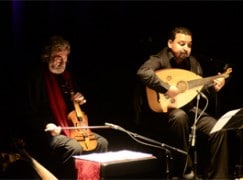Video: Extraordinary Jordi finds his desert sound
mainThe uniquely cross-cultural Jordi Savall is peforming at the Fes Festival of Sacred World Music. Exclusive video and report for slippedisc.com.
Report by Chris Gilchrist, video by Lynn Evans Davidson.

Dar Batha, Fes 17 June 2014 Chris Gilchrist
For the past decade, early music maestro Jordi Savall has been excavating the common musical language of mediaeval Europe and the Middle East. His ‘big band’ Hyperion has played at the Fes Festival of World Sacred Music before, but on this occasion his ensemble consisted of himself on viol and rubab, Driss all Maloumi on oud (lute), Hakan Gungor on kanoon (dulcimer) and Houcin Baqir (percussion).
There can be few better settings for a small group of early music players than Dar Batha. The audience, twenty to fifty feet from the stage in a courtyard under a giant Barbary oak, could catch the nuances of every phrase thrown lightly back and forth between the instruments in a virtuoso rendition of roots medieval.
Savall’s contention is that many of the common tunes found across the Mediterranean originated as sacred chants and morphed as they travelled into laments, dances, romantic songs and lullabies. Those familiar with the Cantigas de Santa Maria heard versions in which the shimmer of the kanoon underpinned a Middle Eastern inflection that sounded entirely authentic.
Oud player Driss all Maloumi probably opened many ears to the virtues of his instrument. His delicacy of touch and phrasing were delightful and he moved seamlessly from a Western lute style to a Middle Eastern one. His soft, fluent voice would have been lost in a large hall, but at the Batha he brought out the poignancy of the lament, whether from Moldova, Armenia or Syria.
The ensemble took the tunes and moved the dial from West to East. One sounded like a troubadour song, while several others emphasised the repeated five-note phrases typical of the Middle East- and says Savall, of all mediaeval Europe in the era before modulation. Some tunes started with the earthy notes of the rubab, an early viol cut from a single block of wood, before lifting into the middle ranges of the oud and the higher registers of the kanoon. Others reversed the sequence, the viol taking the melodic lead and all three instruments together created a surprisingly balanced harmony.
Savall is as much scholar as musician, having traced individual tunes through more than fifteen countries. Versions of many are played today, a contemporary Berber lullaby for example, is the distant descendant of a melody that may have originated in Syria over a thousand years ago.
By demonstrating the commonality of Middle Eastern and European music in the medieval period, Savall has opened a channel to the appreciation of Middle Eastern genres that can seem alien to a modern Western ear. In medieval Europe it seems that we were all singing from the same hymn sheet.





Comments